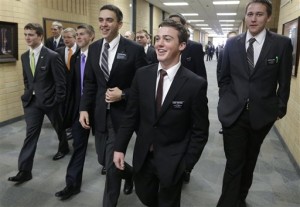
McKay Allred had no idea how his final two years in high school were about to change when he sat down to watch the first session of general conference in fall 2012.
President Thomas S. Monson announced that young men would now be able to serve missions at age 18 and young women at 19. Allred, then a junior in high school, suddenly had to think more realistically about what he was doing to prepare for his mission.
“It changed really fast,” Allred said. “I had been thinking that the soonest I could leave was in over three years, but suddenly I could leave in just over two years. It freaked me out; I needed to start preparing right away.”
When the age requirement for missionary service changed, youths who once waited to begin had to mature faster and begin preparing for their full-time service in high school.
Allred started mission preparation with help from his father and began practicing the missionary lessons with his friends.
“Me and a couple friends would practice the lessons in ‘Preach my Gospel’ and would study up on the scriptures in there,” Allred said. “Then we would go out to another one of our friend’s house that wasn’t with us, and we would teach him.”
The number of active missionaries has grown dramatically since October 2012, from 58,500 to 80,333 in October 2013, as announced by President Monson in general conference.
A recent study presented by Utah Valley University showed that nearly half the missionaries who return early from their missions were not prepared emotionally before serving. However, Aaron Terry, a mechanical engineering major who taught at the MTC for a year before the change and stayed until July 2013, saw the same level of emotional preparation in the younger missionaries as he saw in the older ones.
“To be honest, I didn’t really notice a difference,” Terry said. “If you didn’t tell me which elders were 18, I would not have been able to pick them out. I think elders who went when they were 18 were ready to go, but I think the missionaries who weren’t quite ready, there wasn’t any pressure to leave right when they were 18, so they just came later.”
While MTC instructors were given preparation to help them deal with the increased number of missionaries, Terry said they did not need any additional training to handle younger missionaries.
“I think the only kind of training we got was for the quantity of missionaries; just because there (were) so many more missionaries coming in, we were trained on changing the curriculum from three weeks to two,” Terry said. “One thing I anticipated with the age change was to see more flirting going on because the elders and sisters were closer together in age, but I didn’t see anything different than what would have typically (gone) on.”
According to John Valentine, a senior member of the Utah State Senate and a current bishop, there is more emphasis on mission preparation for young men than ever before.
“After the announcement a lot more people wanted to go immediately,” Valentine said. “They had to start preparing while they were still in high school. … It accelerated the preparation of those wanting to go.”
Chris Killpack, who served as a stake president in Orem, sent out many missionaries under the new age limits, including his own daughter. While his stake didn’t have to make any dramatic changes to its missionary preparation program, it did have to start including young men much sooner in missionary and Melchizedek Priesthood preparation classes.
“It dropped (our young men) into a much more quickly maturing stage, so they were actually moving on in their senior year of high school when other young men would typically enjoy that last senior year having fun with friends,” Killpack said. “Rather than enjoying that mode, they were already in the mode of having interviews with priesthood leaders, filling out mission papers and many things like that that prior young men didn’t worry about until almost a year later.”
Another change young men faced, Killpack said, included having a year less to save for missions.
“It required that others pick up the financial commitment and make up the timeline for them, which wasn’t necessarily a problem but a different challenge.”
Killpack’s sister and brother-in-law are serving as mission presidents in Lansing, Mich., and have seen great success from the younger missionaries.
“They tend to get just a little bit more homesick easily at first, but they catch on to the work very quickly, and those simple things seem to go away just by applying themselves and being faithful missionaries,” Killpack said. “They work through it in a very short period of time, and they prove to be very excellent missionaries.”
Killpack said the majority of the changes were positive and noted that fewer young men fall through the cracks when they don’t have to wait a year between graduation and missionary service.
“They basically are handed off from their bishop and stake president to the mission president without any kind of cracks to fall into; there wasn’t one,” Killpack said. “That’s a great blessing and a big help. We’ve kept a lot of young men that didn’t have to repent of things they got caught up in because they didn’t have time to get caught up in them.”




